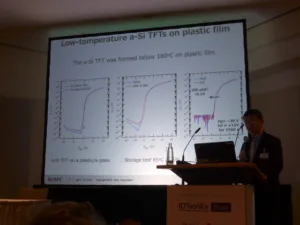Kazumasa Nomoto from Sony covered the topic of TFTs for displays, specifically with regards to flexible and ePaper types.
There are three ‘levels’ to flexible displays, which the industry is progressing through (and towards) now: durable/lightweight; bendable (we are here now); and rollable/foldable. The last stage, which is still ‘behind closed doors’ for most companies, requires a truly flexible backplane and flexible TFTs. All three stages use organic TFTs, said Nomoto.
Very fine (<5µm) alignment is required for the colour (RGBW filter) layer on Sony’s monochrome ePaper displays. These are part of the ‘Mobius’ line, which Sony has been working on for around three years (Display Monitor Vol 20 No 20). The first product produced was a 13.3″ 1600 x 1200 display, with 75 ppi and 13% NTSC coverage.
Since 2013, Sony has produced a 6″ flexible ePaper display using organic TFTs, with 200 ppi. However, it is difficult to manufacture these TFTs through printing, as the technology is not precise enough to reach 5µm (the pixel pitch in the newest display). A new high-precision method is required.

